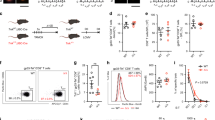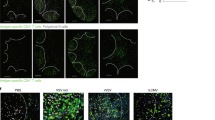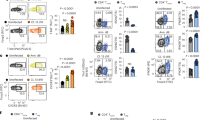Abstract
CD8-positive T cells protect the body against viral pathogens by two important mechanisms: production of antiviral cytokines1,2 and lysis of infected cells3,4. Cytokine production can have both local and systemic consequences5,6, whereas cytolytic activity is limited to infected cells that are in direct contact with T cells7,8,9. Here we analyse activated CD8-positive T cells from mice infected with lymphocytic choriomeningitis virus and find that cytokines are not produced ex vivo in the absence of peptide stimulation, but that they are rapidly generated after T cells encounter viral peptides bound to the major histocompatibility complex. Remarkably, cytokine production ceases immediately upon dissociation of the T cells from their targets and resumes when antigenic contact is restored. In contrast to the ‘on/off/on’ cycling of cytokines, the pore-forming cytotoxic protein perforin is constitutively maintained. Our results indicate that there is differential expression of effector molecules according to whether the antiviral product is secreted (like cytokines) or stored inside the cell (like perforin). The ability to turn cytokines on and off while maintaining intracellular stores of perforin shows the versatility of the cellular immune response and provides a mechanism for maintaining effective immune surveillance while reducing systemic immunopathology.
This is a preview of subscription content, access via your institution
Access options
Subscribe to this journal
Receive 51 print issues and online access
$199.00 per year
only $3.90 per issue
Buy this article
- Purchase on Springer Link
- Instant access to full article PDF
Prices may be subject to local taxes which are calculated during checkout



Similar content being viewed by others
References
Ramsay,A. J., Ruby,J. & Ramshaw,I. A. A case for cytokines as effector molecules in the resolution of virus infection. Immunol. Today 14, 155–157 (1993).
Guidotti,L. G. & Chisari,F. V. To kill or to cure: options in host defense against viral infection. Curr. Opin. Immunol. 8, 478–483 (1996).
Walsh,C. M. et al. Immune fucntion in mice lacking the perforin gene. Proc. Natl Acad. Sci. USA 91, 10854–10858 (1994).
Kagi,D. et al. Cytotoxicity mediated by T cells and natural killer cells is greatly impaired in perforin-deficient mice. Nature 369, 31–37 (1994).
Vassalli,P. The pathophysiology of tumor necrosis factors. Annu. Rev. Immunol. 10, 411–452 (1992).
Tracey,K. J. et al. Shock and tissue injury induced by recombinant human cachectin. Science 234, 470–474 (1986).
Lowin,B., Hahne,M., Mattmann,C. & Tschopp,J. Cytolytic T-cell cytoxicity is mediated through perforin and Fas lytic pathways. Nature 370, 650–652 (1994).
Bossi,G. & Griffiths,G. M. Degranulation plays an essential part in regulating cell surface expression of Fas ligand in T cells and natural killer cells. Nature Med. 5, 90–96 (1999).
Hahn,K. et al. Antigen presentation and cytotoxic T lymphocyte killing studied in individual, living cells. Virology 201, 330–340 (1994).
Whitton,J. L. & Oldstone,M. B. A. in Fields' Virology Vol. 3 (eds Fields, B. N., Knipe, D. M. & Howley, P. M.) 345–374 (Raven, New York, 1996).
Ahmed,R. et al. Selection of genetic variants of lymphocytic choriomeningitis virus in spleens of persistently infected mice: role in suppression of cytotoxic T lymphocyte response and viral persistence. J. Exp. Med. 160, 521–540 (1984).
Byrne,J. A. & Oldstone,M. B. A. Biology of cloned cytotoxic T lymphocytes specific for lymphocytic choriomeningitis virus: clearance of virus in vivo. J. Virol. 51, 682–686 (1984).
Moskophidis,D., Cobbold,S. P., Waldmann,H. & Lehmann-Grube,F. Mechanism of recovery from acute virus infection: treatment of lymphocytic choriomeningitis virus-infected mice with monoclonal antibodies reveals that Lyt-2+ T lymphocytes mediate clearance of virus and regulate the antiviral antibody response. J. Virol. 61, 1867–1874 (1987).
Whitton,J. L. Lymphocytic choriomeningitis virus CTL. Semin. Virol. 1, 257–262 (1990).
Schulz,M. et al. Major histocompatibility complex-dependent T cell epitopes of lymphocytic choriomeningitis virus nucleoprotein and their protective capacity against viral disease. Eur. J. Immunol. 19, 1657–1668 (1998).
Butz,E. A. & Bevan,M. J. Massive expansion of antigen-specific CD8+ T cells during an acute virus infection. Immunity 8, 167–175 (1998).
Murali-Krishna,K. et al. Counting antigen-specific CD8 T cells: a reevaluation of bystander activation during viral infection. Immunity 8, 177–187 (1998).
Whitton,J. L. et al. Molecular analyses of a five-amino-acid cytotoxic T-lymphocyte (CTL) epitope: an immunodominant region which induces nonreciprocal CTL cross-reactivity. J. Virol. 63, 4303–4310 (1989).
Yang,Y., Chang,J. F., Parnes,J. R. & Fathman,C. G. T cell receptor (TCR) engagement leads to activation-induced splicing of tumor necrosis factor (TNF) nuclear pre-mRNA. J. Exp. Med. 188, 247–254 (1998).
Flynn,K. J. et al. Virus-specific CD8+ T cells in primary and secondary influenza pneumonia. Immunity 8, 683–691 (1998).
Sachs,A. B. Messenger RNA degradation in eukaryotes. Cell 74, 413–421 (1993).
Hayden,F. G. et al. Local and systemic cytokine responses during experimental human influenza A virus infection. Relation to symptom formation and host defense. J. Clin. Invest. 101, 643–649 (1998).
Campbell,I. L. Neuropathogenic actions of cytokines assessed in transgenic mice. Int. J. Dev. Neurosci. 13, 275–284 (1995).
Masuda,N. et al. Interleukin 6 is a cause of flu-like symptoms in treatment with a deoxycytidine analogue. Br. J. Cancer 78, 388–389 (1998).
Selin,L. K., Varga,S. M., Wong,I. C. & Welsh,R. M. Protective heterologous antiviral immunity and enhanced immunopathogenesis mediated by memory T cell populations. J. Exp. Med. 188, 1705–1715 (1998).
Tracey,K. J. & Cerami,A. Tumor necrosis factor and regulation of metabolism in infection: role of systemic versus tissue levels. Proc. Soc. Exp. Biol. Med. 200, 233–239 (1992).
Acknowledgements
We thank A. Lord for administrative assistance. The work was supported by grants from the NIH (J.L.W. and M.K.S.) and by Eusko Juarlaritza (F.R.).
Author information
Authors and Affiliations
Corresponding author
Supplementary information
Rights and permissions
About this article
Cite this article
Slifka, M., Rodriguez, F. & Whitton, J. Rapid on/off cycling of cytokine production by virus-specific CD8+ T cells. Nature 401, 76–79 (1999). https://doi.org/10.1038/43454
Received:
Accepted:
Issue Date:
DOI: https://doi.org/10.1038/43454
This article is cited by
-
Viral infections in type 1 diabetes mellitus — why the β cells?
Nature Reviews Endocrinology (2016)
-
Immunotherapy-induced CD8+ T Cells Instigate Immune Suppression in the Tumor
Molecular Therapy (2014)
-
Evaluation of antigen specific recognition and cell mediated cytotoxicity by a modified lysispot assay in a rat colon carcinoma model
Journal of Experimental & Clinical Cancer Research (2012)
-
Δ9-Tetrahydrocannabinol Suppresses Cytotoxic T Lymphocyte Function Independent of CB1 and CB2, Disrupting Early Activation Events
Journal of Neuroimmune Pharmacology (2012)
-
Memory T cells persisting in the brain following MCMV infection induce long-term microglial activation via interferon-γ
Journal of NeuroVirology (2011)
Comments
By submitting a comment you agree to abide by our Terms and Community Guidelines. If you find something abusive or that does not comply with our terms or guidelines please flag it as inappropriate.



